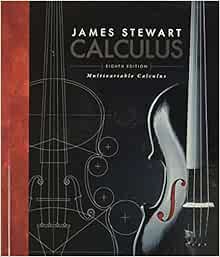Calculus is often seen as one of the most challenging subjects in mathematics, and for good reason. With its intricate concepts, extensive problem-solving techniques, and the need for a solid understanding of algebra and trigonometry, students frequently find themselves overwhelmed. However, with the right strategies and resources, mastering calculus can become an attainable goal. One of the leading textbooks in this field, “Calculus: Early Transcendentals” by James Stewart, offers invaluable insights that can help students navigate the challenges of calculus. This article will explore key tips and strategies derived from Stewart’s 9th edition, helping students to overcome common hurdles in their calculus journey.
Understanding the Foundations of Calculus

Before diving into complex calculus problems, it’s essential to have a strong foundation in the prerequisite topics. Stewart emphasizes the importance of understanding limits, derivatives, and integrals as the building blocks of calculus.
- Limits: Understanding limits is crucial for grasping the concept of continuity and the behavior of functions. Students should practice calculating limits using different methods, including substitution, factoring, and the Squeeze Theorem.
- Derivatives: The derivative represents the rate of change and has numerous applications in various fields. Students should familiarize themselves with derivative rules, such as the product rule, quotient rule, and chain rule.
- Integrals: Integrals help in finding the area under curves and solving problems related to accumulation. Recognizing the Fundamental Theorem of Calculus is vital for understanding the relationship between differentiation and integration.
Effective Study Strategies

Stewart’s textbook is not just a resource for learning; it also offers tips on how to study effectively. Here are some strategies to consider:
- Practice Regularly: Consistency is key in calculus. Regular practice helps reinforce concepts and improves problem-solving skills. Aim to solve a variety of problems, as this will prepare you for different types of questions in exams.
- Utilize Visual Aids: Graphs and diagrams can simplify complex concepts. Stewart provides numerous visual representations in his textbook, which can aid in understanding how functions behave.
- Group Study: Collaborating with peers can enhance understanding. Explaining concepts to others often solidifies one’s own comprehension. Group study sessions can also expose students to different problem-solving techniques.
Breaking Down Complex Problems

Calculus problems can often seem daunting at first glance. However, Stewart suggests breaking them down into smaller, more manageable parts. This approach can help alleviate feelings of overwhelm and clarify the steps needed to find a solution.
- Identify the Problem Type: Determine whether the problem involves limits, derivatives, or integrals. This will guide your approach to solving it.
- List Known Values: Write down all given information. This helps in visualizing the problem and ensures that nothing is overlooked.
- Use Step-by-Step Solutions: Break the problem into smaller steps. For instance, if differentiating a complex function, identify the outer and inner functions to apply the chain rule effectively.
Utilizing Technology and Resources

In today’s digital age, technology can play a significant role in enhancing learning. Stewart’s textbook encourages students to leverage various resources to support their studies.
- Graphing Calculators: Tools like TI-84 or Desmos can help visualize functions and their derivatives or integrals. Graphing calculators are particularly useful for checking work and understanding the graphical interpretation of calculus concepts.
- Online Tutorials: Websites like Khan Academy and Coursera offer free resources and tutorials that explain calculus concepts in digestible formats. These platforms often provide practice problems with immediate feedback.
- Study Apps: Applications like Photomath or Wolfram Alpha can help solve calculus problems and provide step-by-step solutions, aiding in understanding complex topics.
Case Studies: Real-World Applications of Calculus

Understanding the real-world applications of calculus can enhance motivation and interest in the subject. Stewart’s textbook presents various case studies that illustrate how calculus is applied in different fields:
- Physics: Calculus is essential for understanding motion, electricity, and magnetism. For instance, the motion of a falling object can be analyzed using derivatives to find velocity and acceleration.
- Economics: Calculus helps in maximizing profits and minimizing costs. Derivative concepts are used to find marginal costs and revenues, guiding businesses in decision-making.
- Biology: Population growth models often use calculus to predict changes over time. Differential equations can describe the rate of change in populations, helping in ecological studies.
Exam Preparation Tips

As exams approach, students often feel heightened stress. Stewart’s 9th edition offers several strategies for effective exam preparation:
- Review Past Exams: Familiarize yourself with the format and types of questions that are typically asked. This can help in strategizing how to approach the exam.
- Time Management: Practice solving problems within a set time limit. This will improve speed and efficiency, which are crucial during exams.
- Focus on Weak Areas: Identify which topics are challenging and dedicate extra study time to them. Use the textbook exercises to practice these areas extensively.
Calculus can be a challenging subject, but with the right strategies and resources, it is possible to navigate its complexities successfully. Stewart’s 9th edition offers a comprehensive guide, emphasizing the importance of understanding foundational concepts, implementing effective study strategies, breaking down complex problems, utilizing technology, and recognizing real-world applications. By following these tips, students can enhance their understanding of calculus, develop their problem-solving skills, and ultimately improve their performance in this critical area of mathematics. Remember, perseverance and consistent practice are key to mastering calculus, and with dedication, success is within reach.




:max_bytes(150000):strip_icc()/Pink-Ladies-121422-968d2c88643846d6a7c9f095531da656.jpg)